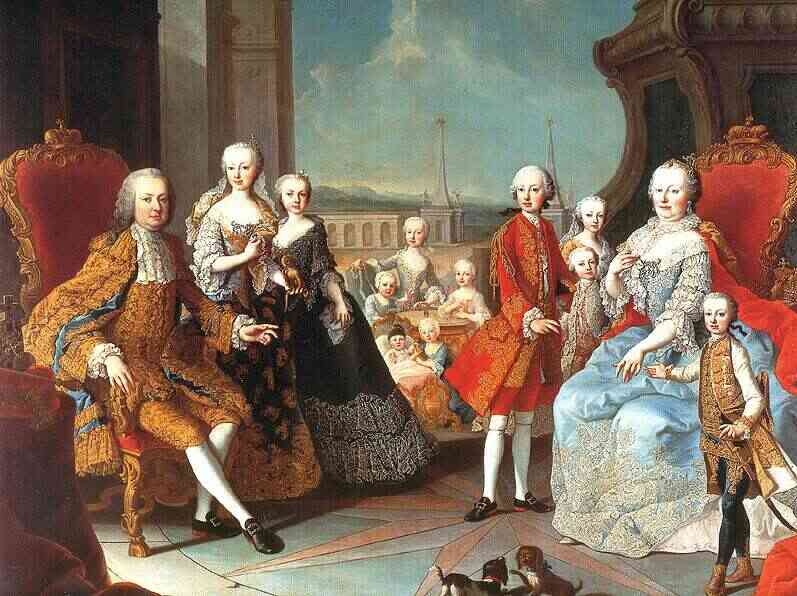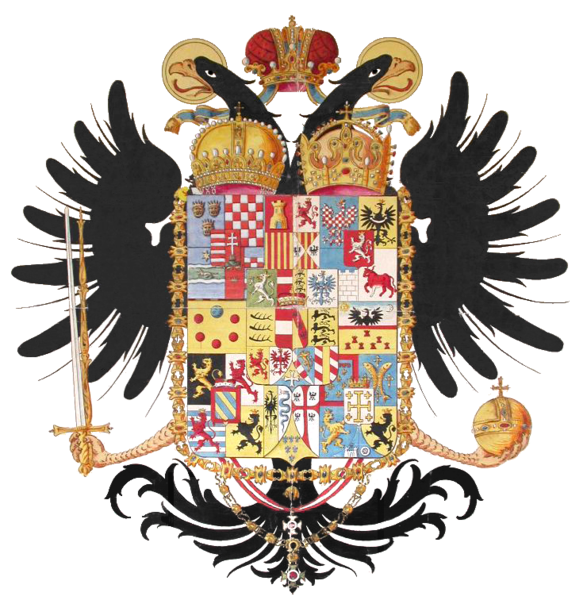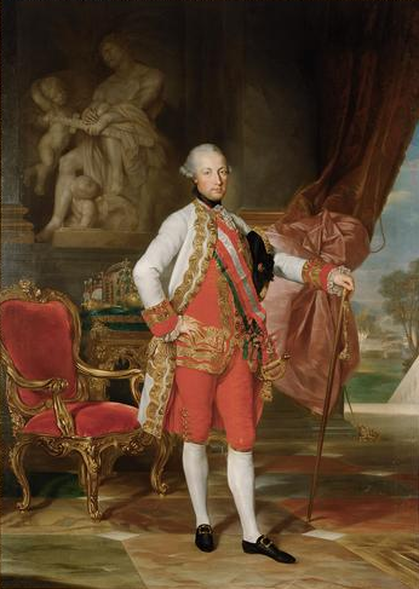Case Study: Austria
by Tilly Behrmann and Britney Spindler
Martin van Meytens' rendition of Maria Theresa and her family, including Joseph II (1751).
Overview
Enlightened Absolutism manifested itself in Austria through the rule of Joseph II and his mother, Maria Theresa. Between the years of 1765 and 1790, Joseph II and Maria Theresa implemented several governmental, religious, educational, and economic reforms. At first, the intent of these reforms were to unify the nation, as Austria was just coming out of the War of Austrian Succession, in which Maria Theresa was initially denied the Hapsburg throne after her father died, as she was a woman. After the conclusion of this conflict between Prussia and Austria, Austria was left in a rather precarious position, having lost Silesia to Prussia. Thus, it was necessary for Maria Theresa to secure her position as a concrete and competent ruler. Furthermore, the concept of enlightened absolutism became an efficient vehicle for this goal, as it would improve life for Maria Theresa's subjects, as well as consolidate and strengthen the royal power. Because Maria Theresa lived most of her life during the Baroque and Rococo periods, it was a challenge for her to conform to the majority of Enlightenment reforms. She opposed the abolition of torture, which was highly unorthodox for the Enlightenment sphere of reform. While Maria Theresa took more deliberate and gradual steps in implementing enlightenment ideals (peasant working rights, centralizing authority, educational reforms), Joseph's reforms were much less moderate, focusing on the abolition of serfdom and extreme measures towards unification. In addition, Joseph II was a strong supporter of Febronianism, or the restriction of the Pope's power. Because of his extreme reforms and stances, Joseph II was met with much resistance and criticism by nobles and clergymen. Eventually, the Austrian enlightenment lost some of its momentum after Joseph II died, and Leopold, his son and successor, abolished some of the more radical pieces of legislation passed by Joseph.
Social and Economic Reforms
Both Maria Theresa and Joseph II sought to implement economic reforms, especially in taxing and tariffs in order to maintain a more cohesive and unified monarchy. These economic reforms were important in the creation of a new social system, particularly the disappearance of the serf class in Austria.
In Maria Theresa's rule, much of her economic policies were based loosely upon enlightenment ideals. For instance, Maria Theresa implemented a more efficient system of taxation. Nobility and clergymen were no longer exempted from taxes; thus, the burden of taxation was somewhat alleviated from the peasant class. To further stimulate the economy, Maria Theresa encouraged free trade through the elimination of tariffs between Austria, Bohemia, Moravia, and the Austrian duches. Throughout these reforms, Austria enjoyed a more efficient economy with less severe class disparities. In addition to these economic reforms, Maria Theresa slowly attempted to limit the prominence of serfdom in Austrian society. By passing legislation that limited the amount of work landowners could bestow upon the serfs, she not only increased the rights of Austria's serf class, but also increased the total amount of possible military recruits for Austria's growing army. As stated before, Maria Theresa, although progressive in her economic reforms, slowly implemented her enlightenment-based policies, and remained relatively conservative socially. Her son, Joseph II, however, enforced sweeping reforms. He extended Austrian influence to Hungary, for instance, showing an even greater centralization of power. While Maria Theresa opposed serfdom, Joseph II set out to abolish it. In the Serfdom Patent of 1781, Joseph II detailed the rights of serfs: 1. Any subject is entitled to marry, subject to previous notification and acquisition of a certificate, to be delivered free of charge. In this excerpt from Joseph II's patent, a opposition of the institution of serfdom is utterly apparent. Joseph's steps towards social reform can be seen to be He imposed equal taxation and equal punishment, regardless of social class. By ridding Austria of all internal tariffs, free trade was increased even more, as well as communication and travel through the increased presence of roads and river transport. His most significant economic reform, however, was the advent of land taxation. With this development, all landowners were obliged to pay taxes, not just peasants. This, coupled with the elimination of torture and other physical punishments, represented the various enlightenment ideals taken into account in Joseph II's rule, such as property rights, religious freedom, and right to life.
Portrait of Maria Theresa (Martin van Meytens, 1759)
|
To the left: The Heraldic Shield of Joseph II.
Education Reform
Maria Thersa: In 1775, education was reformed to more closely resemble Prussia educational systems. Boys and girls ages 6-12 had to attend school. To combat opposition, she arrested those dissenting parties. In spite of these reforms, roughly 50% of Austrian population in some regions was illiterate. Furthermore, she allowed non-Catholic people to attend university and introduced secular subjects into university curriculum.
Joseph II: Joseph II continued the educational reforms started by his mother. Education was compulsory for all boys and girls, and in 1784 language of instruction was changed from Latin to German. Joseph II as painted by Anton von Maron.
Religious Reforms
Maria Theresa was a pious Catholic who was very intolerant of other faiths. "Cujus regio, ejus religio" meaning "Whose realm, his religion". Essentially, this means that the ruler determines the religion of the state. Maria Theresa applied this to her rule of the Austrian empire. She encouraged conversion to Catholicism, and Protestants were treated as second-class citizens while Jews were harshly cast from her favor. In 1741, she expelled Jews from Prague (then part of the Austrian empire). In spite of her piety, she did propose a gradual departure of the church from secular activities.
This type of policy was met with swift opposition from Joseph II, as he took the throne: "I determined from the very commencement of my reign to adorn my diadem with the love of my people, to act in the administration of affairs according to just, impartial, and liberal princples; consequently, I granted toleration [in 1781], and removed the yoke which had oppressed the protestants for centuries. This quote shows Joseph II's radical views on religion. Joseph II proposed harsh reforms of the Catholic church as it existed in Austria. He desired to make it an entity independent of the Roman Catholic church which ruled most of Europe, and changed the Mass, the number of holy days recognized by the Empire, defined marriage as a civil contract, and reduced the number of monks and nuns by half. He aspired to make the church a tool of the state, and ordered all bishops to take an oath of loyalty to the crown. These reforms were staunchly criticized and eventually repealed. He also promoted religious tolerance and protected Jews, passing concrete laws regarding tolerance (Tolerance Decree of 1781), and traveling the country, personally ensuring that these laws were being upheld.
Criticism for Joseph II
Naturally, Joseph's swift reforms sparked much criticism, especially in Hungary and Belgium, where citizens felt that the ruler's reforms were overly pervasive. Many individuals in these regions felt that Joseph II was acting out of personal wishes, rather than the actual good of the people. Individuals criticized Joseph's secret police as being hypocritical of his enlightenment policies. Strives to make German the official language of Hungary and Belgium were also met with opposition, as was the strive to eliminate regional officers in the place of a totally centralized government. Ultimately, this caused several rebellions in Hungary and Belgium, forcing Joseph II to repeal some of the reforms he had enacted. In addition to the peoples of Belgium and Hungary, nobility and clergymen held animosity towards Joseph's rule. The egalitarian culture that Joseph II promoted threatened the wealth of these individuals and contrasted the traditional ideology of Austria.
|
Continuities and Changes - WHAT'S THE BIG DEAL?!?
Though Maria Theresa and Joseph's total economic, societal, religious, and political reforms were met ultimately with opposition, and later repealed in Leopold's rule, Austria's despotism serves as a prime example of progressive government that eventually laid the framework for modern forms of government. Ideals, such as fair taxation and readily available education have remained constants throughout western history. And although religious tolerance and fair punishment for crimes have varied throughout history, ultimately, these ideals have prevailed. It is important to note, however, that this analysis only applies infallibly to Western cultures; because Asian countries and African countries never experienced the same sort of enlightenment present in Europe during this period of time, the nations were affected differently.
What has noticeably changed in the western world, nonetheless, is the role of government in facilitating enlightenment ideals. In the case of Austria, government control was paramount. The government was centralized, and although it protected the rights of the citizens and supplied them with better lives, the citizens still remained relatively powerless in relation to their rulers. Today, this has changed in that many western governments empower their citizens through enlightenment ideals, rather than using them as vehicles for maintaining the control and the loyalty of their subjects.
What has noticeably changed in the western world, nonetheless, is the role of government in facilitating enlightenment ideals. In the case of Austria, government control was paramount. The government was centralized, and although it protected the rights of the citizens and supplied them with better lives, the citizens still remained relatively powerless in relation to their rulers. Today, this has changed in that many western governments empower their citizens through enlightenment ideals, rather than using them as vehicles for maintaining the control and the loyalty of their subjects.
Works Cited
"Letters of Joseph II," in The Pamphleteer, London, XIX (1822), p. 290
Löffler, Klemens. "Maria Theresa." Catholic Encyclopedia. Ed. Kevin Knight. N.p., 2009. Web. 21 Mar. 2013. <http://www.newadvent.org/cathen/09662d.htm>.
"Maria Theresa of Austria." New World Encyclopedia. N.p., 25 Aug. 2008. Web. 23 Mar. 2013. <http://www.newworldencyclopedia.org/entry/Maria_Theresa_of_Austria>.
U.S. Library Of Congress. "THE REFORMS OF MARIA THERESA AND JOSEPH II." Country Studies. U.S. Library of Congres, n.d. Web. 25 Mar. 2013. <http://countrystudies.us/austria/17.htm>.
Löffler, Klemens. "Maria Theresa." Catholic Encyclopedia. Ed. Kevin Knight. N.p., 2009. Web. 21 Mar. 2013. <http://www.newadvent.org/cathen/09662d.htm>.
"Maria Theresa of Austria." New World Encyclopedia. N.p., 25 Aug. 2008. Web. 23 Mar. 2013. <http://www.newworldencyclopedia.org/entry/Maria_Theresa_of_Austria>.
U.S. Library Of Congress. "THE REFORMS OF MARIA THERESA AND JOSEPH II." Country Studies. U.S. Library of Congres, n.d. Web. 25 Mar. 2013. <http://countrystudies.us/austria/17.htm>.




